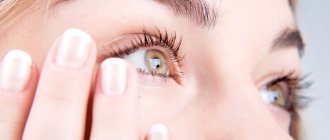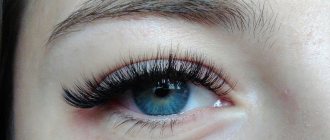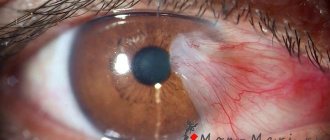How does pain in the corners of the eyes manifest?
It is worth noting! Pain in the corners of the eye is extremely rarely an independent phenomenon. Often this phenomenon is accompanied by additional symptoms:
- itching and burning sensation;
- feeling as if there is a foreign body in the eye or sand under the eyelids;
- there is redness of both the corners of the eye and the conjunctival membrane;
- increased uncontrolled tearing;
- photophobia (photophobia);
- the appearance of copious uncharacteristic discharge from the eyes.
The pain syndrome may occur periodically or persist constantly .
In the first case, this may indeed indicate overwork and irritation against its background, but if pain occurs systematically, this is a reason to consult an ophthalmologist.
Why does the corner of the eye swell?
Canaliculitis
Inflammation of the lacrimal canaliculus is called canaliculitis. With this disease, the inner corner of the eye becomes inflamed, red, and swollen. Mucopurulent lacrimation and crusts in the corner of the eye may also be observed. Swelling is observed along the lacrimal canaliculus, in appearance it resembles barley. If you press on the lacrimal canaliculus, you can observe a cloudy purulent discharge with particles of calculi (dense formations).
Obstruction (blockage) of the lacrimal ducts
This disease can occur for a number of reasons:
- congenital blockage,
- infectious inflammation,
- age-related narrowing of channels,
- facial injuries around the eyes,
- tumors and other formations.
In this case, the following symptoms are observed:
- lacrimation, sometimes with blood,
- swelling and redness in the inner corner,
- mucus secretion.
Dacryocystitis
If the corner of the eye is swollen and painful, the cause may be inflammation of the lacrimal sac. This disease is called dacryocystitis. The disease can be acute or chronic, and can also be congenital or acquired. Inflammation is usually unilateral. With dacryocystitis, the following symptoms are observed:
- swelling of the inner corner of the eye,
- redness,
- lacrimation with purulent impurities,
- soreness.
Blepharitis
Blepharitis is a disease characterized by inflammation of the edges of the eyelids. Most often, the disease is caused by Staphylococcus aureus, as well as fungi, mites and bacteria. Blepharitis affects both eyes. Swelling of the inner and outer corners of the eye most often occurs with angular blepharitis. In addition, symptoms such as:
- redness of the tips of the eyelids,
- itching,
- crusts and scales near the eyelashes,
- eyelash loss,
- lacrimation,
- photophobia.
Blepharitis is often chronic and difficult to treat.
Diplobacillary (angular) conjunctivitis
The causative agent of the disease is diplobacillus Morax-Axenfeld. Such a microorganism can get on the mucous membrane of the eye when washing or swimming in a dirty pond, as well as through towels or dirty hands. Symptoms of angular conjunctivitis:
- itching and burning in the corners,
- pain when blinking,
- crusts and cracks that do not heal for a long time,
- secretion of viscous mucus.
With this disease, both corners are affected. With improper treatment or its absence, a chronic form develops.
Herpetic infection
Herpes infection is another unpleasant and contagious disease that can cause redness and swelling in the corner of the eye. In addition, severe itching and burning may occur, especially in the outer corner, and pain may appear. The rash of ocular herpes usually appears as blisters and often affects the upper eyelid.
Computer vision syndrome
If the inner corner of the eye is slightly swollen, or itching appears, which makes you want to rub your eyes with your hands, a possible reason could be working in front of a computer monitor for a long time. If you look at a screen for a long time, a person begins to blink less often. In this case, the mucous membrane dries out and dry eye syndrome occurs, which is characterized by the sensation of a foreign body (sand), sensitivity and irritability of the eyes, photophobia, and redness. In some cases, cutting pain appears in the corners, especially when blinking.
Other reasons
There are also a number of not very dangerous factors characterized by swelling of the corners of the eyes.
The entry of a foreign body (mote) leads to the fact that a person begins to intensively rub his eyes with his hands. In this case, the speck often moves to the inner or outer corner, where it provokes even greater irritation.
An insect bite (such as a mosquito) causes swelling and itching at the site of the bite.
If a person sleeps on a feather pillow, a prick from the tip of a feather can also cause irritation and slight swelling of the delicate skin around the eyes. In this case, the outer corners are most often affected.
An ingrown eyelash is another cause of swelling and stabbing pain. The inner corner is often affected, as this is where the thinnest and smallest eyelashes grow.
Causes of the phenomenon
Common causes of pain in the outer and inner corners of the eye include :
- Overwork . It is diagnosed only in cases where, after resting for several hours, the pain goes away without the use of medications and is not accompanied by other signs of ophthalmological disorders.
- Barley. An inflammatory disease in which pain is localized in the upper and lower eyelids and spreads to the corners of the eyes.
- Negative effects and irritation due to incorrectly selected optics. In this case, the pain is not of physiological origin, but occurs due to rapid fatigue of the visual organs, which is additionally accompanied by headaches. Separately, it is worth mentioning the pain of the inner corners when wearing glasses, when the symptom is caused by pressure on the corners from incorrectly adjusted nose pads.
- Demodectic mange . This is a lesion of the skin of the periocular space by the conditionally pathogenic microorganism Demodex. With normal functioning of the immune system and the absence of predisposing factors, this microorganism from the group of parasitic ticks is harmless. But in infectious and inflammatory diseases (not necessarily ophthalmic), the microorganism exhibits negative activity.
- Allergic reactions . In such cases, the pain affects different parts of the periocular space, including the corners. It is characterized by additional symptoms such as nasal congestion, irritation and redness of the conjunctiva and severe lacrimation.
- Dacryocystitis. Such a violation of the patency of the lacrimal canal provokes the development of inflammatory processes and, as a result, pain.
- Canaliculitis . A lesion of the tear ducts similar to dacryocystitis, characterized by inflammation. Unlike dacryocystitis, which is an independent pathology that occurs due to obstruction of the lacrimal canaliculi, canaliculitis is a side pathology that spreads due to infectious lesions of the conjunctiva.
Most of the listed pathologies have similar symptoms, such as the appearance of purulent mucous discharge, photophobia and irritation of the visual organs.
In such cases, only a doctor can accurately determine the cause of pain in the corners of the eyes .
Pain in the inner corners closer to the nose
Pain in the inner corners of the eyes often indicates infectious and inflammatory diseases : blepharitis, conjunctivitis, demodicosis, or occurs due to obstruction of the lacrimal canals - dacryocystitis.
The inner corners are the area under which the lacrimal sac is located.
It is susceptible to inflammatory processes upon contact with pathogenic microflora, and if this happens, corresponding pain sensations appear in the inner corners of the eyes.
Often this symptom indicates infection with the herpes virus .
In such cases, the virus can enter the lacrimal sac or tear ducts both from inside the body and be introduced from the outside (including if a person with herpes touches their eyes with dirty hands).
Keep in mind! With allergies, the inner corner of the eye becomes inflamed more often than the outer corner.
Treatment options
There is no clear way to eliminate pain in the corners of the eyes: it all depends on the nature and severity of the lesion. In any case, the main method of treatment is conservative drug therapy .
For bacterial and viral infections, ophthalmic solutions or ointments (or a combination thereof) are used for this purpose.
This may be sofradex, ciprofloxacin, poludanum (if the disease was caused by a virus) or antibacterial drugs tobrex, gentamicin, oftadec, albucid.
Allergies that manifest themselves in this way are treated by instillation or oral administration of antihistamines :
- Telfast;
- allergodil;
- erius;
- olopatadine;
- suprastin;
- azelastine.
Important! Canaculitis requires symptomatic and immediate treatment. To eliminate inflammation, the same antibacterial and painkillers are used as for other infectious eye lesions.
In case of complications such as blockage of the canals, surgical intervention is required to widen them.
After such a procedure, it is also necessary to apply medications directly to the internal walls of the canals to combat bacterial and fungal pathogens and prevent their further spread.
If a patient is diagnosed with demodicosis , the disease is eliminated by applying bactericidal ointments to the edges of the eyelids and instilling antiparasitic solutions (one of them is carbachol).
The Demodex mite, which causes this pathology, mainly lives in the eyelash follicles.
Therefore, it is important to distribute the ointment along the entire eyelash line to cleanse all follicles of the pathogen.
With barley, pain is a consequence of inflammatory processes, in turn they come from a granular purulent formation (or accumulations of such formations).
For your information! Usually, such abscesses open on their own over time, and as a treatment it is enough to instill antibacterial solutions in order to prevent and exclude damage to the conjunctiva when purulent contents get on it.
In rare cases of complications of barley, the abscess is opened by a surgeon.
Diseases caused by infection
- Canaliculitis is a disease that is accompanied by inflammation of the tear ducts.
The cause of this pathology is most often non-compliance with hygiene rules. A person with dirty hands introduces a pathogen into the eyes: bacteria or fungus.
Canaliculitis is accompanied by swelling of the eyelid, stabbing pain in the bridge of the nose, and discharge from the eyes that is mucous or purulent in nature.
A patient with this diagnosis is prescribed a course of treatment with antibiotics for bacterial etiology or antifungal drugs.
In severe cases, surgical intervention is required to remove the purulent contents of the lacrimal canal.
- Dacryocystitis is inflammation of the lacrimal sac.
With this pathology, significant lacrimation, acute pain, and swelling in the corner of the eye are observed. The disease occurs when infected with a bacterium or as a complication after suffering from acute respiratory viral infection or influenza.
Dacryocystitis in adults
The disease is treated with antibiotics for external and internal use. Anti-inflammatory and restorative drugs are also prescribed. If there is obstruction of the nasolacrimal duct, then surgery is necessary.
- Blepharitis is a disease in which inflammation of the ciliary space of the eye occurs.
The causative agent of this pathology is most often Staphylococcus aureus. The disease is accompanied by hyperemia of the eyelids, loss of eyelashes, peeling of the skin in front of the eyes and itching. Blepharitis is treated with the following medications:
- Erythromycin;
- Ofloxacin;
- Oftagel.
What is blephrit
Oftagel is a drug for moisturizing the cornea. The product forms a film that protects the cornea from harmful pathogens. Removes the feeling of itching and burning in the eyes.
The drug must be used by instilling 1 drop into the conjunctival sac. Before the procedure, you need to wash your hands thoroughly.
Prevention
Prevention of pain in the corners of the eyes itself is impossible: the patient is required to prevent the development of the pathology that causes such a symptom.
To do this , you need to protect yourself from infectious diseases by maintaining personal hygiene (do not use other people’s cosmetics and cleansers, as well as towels, contact lenses and even eye drops).
To reduce the risk of activation of pathogenic and conditionally pathogenic microflora that causes ophthalmic diseases, it is necessary to strengthen the immune system by taking regular walks in the fresh air, maintaining an active lifestyle and eating as much healthy food as possible (fruits, vegetables, natural juices).
Treatment of diseases
You can eliminate pain in the corners of the eyes if you cure the underlying disease or condition that led to the discomfort:
- For allergies, taking antihistamines is indicated.
- Inflammation of the tear ducts requires surgery. At the initial stage, you can treat with antibacterial drops.
- For conjunctivitis, antiseptics, regenerative drugs and antihistamines are prescribed (depending on the type and cause of the disease).
- For myositis, the doctor prescribes corticosteroids, and surgery may be prescribed.
- For barley, dry heat (at an early stage of the disease) and antibacterial drops are indicated.
- For dacryocystitis, treatment is indicated in 2 stages: restoring the patency of the nasolacrimal duct surgically and using antibiotics and anti-inflammatory drugs.
Drugs for the treatment of the conditions described above are prescribed by an ophthalmologist. Additionally, you can use folk remedies.










